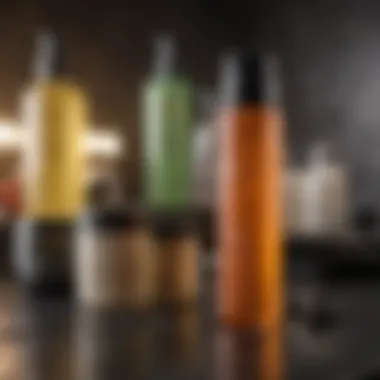Best Affordable Shampoo and Conditioner Reviews


Intro
Hair care is a significant aspect of personal grooming that many people take seriously. Having the right shampoo and conditioner can make a noticeable difference in the health and appearance of hair. In a market flooded with choices, identifying effective and affordable products can be a daunting task. This article will explore various criteria for selecting hair care products, focusing on the best and cheapest options currently available. It is essential to understand the different needs based on hair type and the performance of key ingredients used in these products. This knowledge will help readers make informed decisions about their hair care routine that align capabilities and budget.
Key Trends
Overview of Current Hair Care Trends
The hair care industry is continuously evolving. Recent trends show a shift toward natural ingredients that promote healthier hair without harsh chemicals. Many consumers are looking for products that not only wash and condition but also treat specific hair concerns, such as dryness, damage, and color fading. Brands are responding to this demand by formulating products with plant-based ingredients and avoiding sulfates and parabens. \n
Popular Beauty Trends
Another prevailing trend is customization. Personalized hair care products that cater to individual hair types and concerns are gaining a foothold. More brands are now offering quizzes or consultations so users can receive recommendations better suited to them. Furthermore, sustainability is a rising concern in beauty. Many companies are adopting eco-friendly practices, such as using recyclable packaging and sourcing ingredients responsibly.
Understanding Your Hair Type
Different hair types require different care. Here’s a brief overview:
- Straight Hair: Usually less prone to tangles and oil build-up. Look for lightweight shampoos and conditioners that provide moisture without weighing hair down.
- Wavy Hair: Needs a balance of moisture and hold. Products that offer frizz control and definition work best.
- Curly Hair: Often dry and needs extra moisture. Choose hydrating shampoos and richer conditioners.
- Coily Hair: Typically the driest type. Look for products with high moisture content, often labeled as curl-defining or hydrating.
Evaluating Ingredients
When considering affordable shampoos and conditioners, it is vital to evaluate the ingredient list. Here are common ingredients to look for:
- Coconut Oil: Known for its moisture-retaining properties. Helps to prevent dryness and damage.
- Argan Oil: Helps to nourish hair and enhance shine.
- Keratin: Improves elasticity and strength.
- Natural botanical extracts: Like aloe vera, which hydrates and soothes the scalp.
Similarly, avoid harmful additives like sulfates, which strip hair of its natural oils, and parabens, which can interfere with hormone function.
"Choosing the right shampoo and conditioner is not only about price but also the formulation that fits your hair needs."
Making an Informed Choice
When choosing the best and cheapest shampoo and conditioner options, consider not just the price but also the effectiveness. Sometimes, a slightly higher price can mean significantly better results, particularly if it reduces the need for additional products down the line.
Additionally, read reviews and ratings from different sources. Engaging with communities on platforms like Reddit or popular beauty blogs can provide insight into how others feel about specific products. Social media platforms such as Facebook also serve as great resources where users share experiences and recommendations.
Understanding the balance between quality, performance, and affordability can take your hair care routine to another level. As you select products, remain aware of your hair's unique requirements and how different ingredients can fulfill them.
Understanding Hair Care Essentials
Understanding hair care essentials is crucial in navigating the extensive market of shampoos and conditioners. Recognizing the fundamental role these products play in maintaining hair health can lead to better choices and, importantly, satisfaction with hair care routines.
The Role of Shampoo
Shampoo serves as the initial step in the hair care regimen. Its primary purpose is to cleanse the scalp and hair of oils, dirt, and product buildup. A well-formulated shampoo removes impurities without stripping essential moisture. Individuals should be mindful of their hair type and specific needs when selecting a shampoo. For instance, those with oily hair may favor formulations that effectively eliminate excess oil, while those with dry hair might seek gentler, moisturizing options.
Choosing the right shampoo also involves understanding the ingredients. Some harmful elements, like sulfates, can lead to dryness and irritation. Instead, look for shampoos containing natural cleansers such as cocamidopropyl betaine. In addition, understanding the pH balance in shampoo can help maintain the scalp's natural acidity, essential for overall hair health.
The Importance of Conditioner


Condtioner is typically applied after shampooing and plays a vital role in restoring the moisture and nutrients lost during cleansing. It helps to detangle hair, making it more manageable and less prone to breakage. Conditioners work by coating the hair shaft, that shields it from environmental factors and physical damage.
Utilizing a conditioner tailored to one’s hair type ensures the best results. Those with color-treated hair may need a conditioner designed to preserve color vibrancy, while those with curly hair might benefit from a heavier, moisturizing formula that adds definition and reduces frizz.
The timing and method of application are also important. It is advisable to focus the conditioner on the mid-lengths to ends, avoiding the roots unless additional moisture is essential. An effective conditioner can dramatically improve the overall appearance and feel of the hair.
Criteria for Selecting Shampoo and Conditioner
Choosing the right shampoo and conditioner requires careful consideration. While many products claim to perform miracles, understanding a few essential criteria can significantly enhance the decision-making process. This section outlines the critical aspects to consider when selecting these hair care products to ensure they address both your hair's needs and your budget efficiently.
Understanding Ingredients
One of the foremost criteria in selecting shampoo and conditioner lies in the ingredient composition. Ingredients dictate how effectively a product cleanses, nourishes, and protects hair. Natural ingredients, such as aloe vera or coconut oil, often provide hydration and shine without harsh effects. Conversely, sulfates and parabens may strip natural oils, leading to dryness or irritation. Paying attention to the ingredient list allows users to avoid potential allergens and subpar formulations. It’s essential to familiarize yourself with common beneficial components and avoid synthetic additives that could pose risks to your hair health.
Assessing Performance Metrics
Performance metrics serve as a benchmark to evaluate how well a shampoo or conditioner meets its intended purpose. Key factors include how well it cleanses, detangles, moisturizes, and overall suitability for your hair type. Users should also consider how their hair feels post-wash; for instance, does it feel clean yet hydrated? Customer reviews often offer invaluable insights into real-life performance. Ingredients like keratin can add strength for damaged hair, while lightweight formulas might work better for fine hair. Thus, assessing performance metrics can lead to choosing products that deliver on their promises effectively.
Evaluating Price Points
Lastly, while budget is an undeniable consideration, it's crucial to understand the relationship between price and quality. Expensive does not always equate to better performance. Some affordable shampoos and conditioners might provide more value than high-end counterparts. Researching price points involves examining the cost per ounce and comparing various brands to determine which offers the best cost-performance ratio. This understanding helps in making smart purchases that align with financial constraints while still achieving satisfactory results.
"You often get what you pay for, but in the realm of hair care, savvy consumers can find top-quality options without breaking the bank."
By carefully evaluating these criteria—ingredients, performance, and price points—individuals can hone in on the best shampoo and conditioner tailored to their specific hair concerns and budgetary constraints.
Identifying Hair Types and Needs
Understanding individual hair types and their specific needs is crucial when selecting effective hair care products. The diversity of hair textures and conditions across different individuals necessitates a tailored approach for shampoos and conditioners. Poor choices can lead to ineffective results, damaging effects, or even excess expenses. Thus, recognizing your hair type ensures that you select appropriate products that address your unique concerns.
When evaluating shampoos and conditioners, consider the following elements:
- Secretion of Natural Oils: Hair type can determine how much natural oil your scalp produces. Oily hair generally needs more cleansing, while dry hair might require moisturizing products.
- Scalp Sensitivity: Some scalps are more sensitive and may react negatively to certain ingredients. Identifying your scalp's condition is essential for product safety.
- Texture and Volume: Straight, wavy, curly, or coily types may have vastly different requirements. Different textures may respond better to specific formulations.
When we align our hair care routine with our hair’s needs, we optimize health, manageability, and appearance.
Oily Hair Considerations
Oily hair can be a significant concern for many. It is often characterized by an excess of sebum, which can lead to greasy roots and limp strands. Individuals with oily hair must focus on products that effectively cleanse without over-stripping moisture, which can lead to rebound oiliness. Consider lighter formulas that include clarifying ingredients like salicylic acid or tea tree oil. These ingredients can help in breaking down excess oil, keeping hair looking fresh longer. Regular washing is also beneficial, but over-washing may lead to irritation or an imbalance in oil production.
Dry and Damaged Hair Care
Dry and damaged hair signifies the loss of moisture or structural integrity. It tends to look dull, frizzy, and can feel brittle. Addressing this requires regular use of hydrating products. For such hair types, conditioners rich in humectants, like glycerin or aloe vera, can significantly improve moisture retention. Additionally, nourishing oils, such as argan oil or jojoba oil, can provide essential lipids and help seal cuticles. Incorporation of leave-in treatments may enhance hydration and promote recovery for damaged strands.
Color-Treated Hair Needs
Color-treated hair often demands special attention, as the dyeing process can strip natural oils and moisture. This hair type usually requires sulfate-free shampoos to prevent color fading and maintain vibrancy. Conditioners rich in protein can also aid in rebuilding hair strength after processes that weaken hair structure. Regular deep conditioning treatments are highly recommended to restore moisture and shine. Look for products specifically formulated for color protection to ensure longevity in color and overall health of your tresses.
Curly and Textured Hair Solutions
Curly and textured hair often has unique challenges, such as dryness and frizz. Moisture is key for managing curls, thus requiring rich, hydrating shampoos and conditioners. Focus on products containing shea butter, coconut oil, or other emollients that can penetrate and sustain moisture. Additionally, the use of co-washing, which involves washing hair with conditioner alone, can help preserve natural oils and moisture balance. Curls thrive best with products that promote definition and limit frizz, therefore routine experimentation with various formulas may enhance curl appearance and feel.


This detailed understanding of hair types not only informs choices but enhances experiences. Tailored hair care can significantly impact the quality of hair and contribute to overall satisfaction with your grooming routine.
Top Affordable Shampoo Products
In recent years, the demand for affordable shampoo products has increased significantly. Consumers are seeking options that do not compromise on quality while being budget-friendly. Evaluating these products is crucial for several reasons. First, the wrong choice can lead to issues such as scalp irritation or damage to hair. Second, with so many brands claiming to be the best, navigating this crowded marketplace requires careful consideration. Lastly, understanding the effectiveness of these products ensures that consumers can maintain healthy hair without overspending. In this section, we will delve into the analysis of popular brands, performance comparisons, and a thorough price evaluation.
Analysis of Popular Brands
The market for affordable shampoos includes a variety of well-known brands. Some of the most recognized names include Pantene, Garnier Fructis, and Herbal Essences. These brands often utilize innovative marketing strategies to position themselves as effective solutions for different hair types.
- Pantene is known for its Pro-V formula, claiming to strengthen hair from root to tip.
- Garnier Fructis positions its products as both effective and nourishing, frequently highlighting the use of fruit extract in their formulations.
- Herbal Essences emphasizes botanical ingredients, catering to those seeking natural solutions.
Each of these brands has a loyal customer base, often driven by personal experiences and positive feedback. However, it is essential to dig deeper and examine their respective ingredient lists and claims.
Performance Comparisons
Comparing the performance of these shampoo products involves looking at several key factors: cleansing ability, moisture retention, and overall hair health improvement. For instance, Pantene shampoos generally excel at removing buildup without overly stripping natural oils from the hair. On the other hand, Garnier Fructis is particularly effective for individuals who suffer from dryness, thanks to its hydrating ingredients. Meanwhile, Herbal Essences users often report increased softness and manageability, aligning with their focus on nature-inspired formulas.
In practice, consumer reviews and independent studies show varied results depending on hair type. Thus, consumers should choose products aligned with their specific hair needs:
- For oily hair, a clarifying shampoo from Pantene may be advisable.
- Those with dry hair might favor Garnier Fructis for its moisture-rich properties.
- Curly hair individuals may benefit most from Herbal Essences, which can enhance curl definition and minimize frizz.
Price Evaluation
Price is an essential factor in determining the affordability of shampoo products. Pantene shampoos typically range from $5 to $10 for standard bottles, making them accessible for daily use. Garnier Fructis is often priced similarly, with occasional discounts or sales that make them even more appealing. Herbal Essences can be slightly higher but is often found in bundle discounts.
Affordability does not always correlate with quality, and understanding pricing strategies helps consumers make informed decisions. It is valuable to consider the cost-per-use; even if a product is slightly more expensive, its effectiveness may lead to less frequent use or overall better outcomes, thus saving money in the long run.
"Choosing the right shampoo can significantly impact your overall hair health, blending quality with cost-effectiveness is key to a successful hair care routine."
Best Value Conditioners Available
Understanding the importance of value conditioners in this article is vital. Conditioners are essential in maintaining hair health, providing moisture, and enhancing manageability. For many, cost can be a deciding factor when choosing a conditioner, yet affordability should not come at the expense of quality. This section will delve into what makes a conditioner valuable while remaining budget-friendly. By evaluating various products on the market, readers can discover options that meet both their needs and financial considerations.
Criteria for Evaluation
When assessing value conditioners, it is necessary to look at several key criteria:
- Ingredient Quality: Evaluate the main ingredients to ensure they promote hair health and avoid harmful chemicals. For instance, natural ingredients like coconut oil or shea butter may enhance moisture.
- Hair Type Compatibility: Not every conditioner suits every hair type. It is essential to match products with specific hair needs, such as hydration requirements or smoothing effects.
- Performance: Consider how well the conditioner works. Does it improve combability, reduce frizz, or add shine? Observing tangible results offers insights into the product's efficacy.
- Price Point: Analyze the cost in relation to the product size and performance. Sometimes, a slightly higher price reflects superior quality or ingredients.
- Brand Reputation: Researching a brand's history and consumer trust can provide confidence in a product's quality.
Most Recommended Products
Several conditioners have emerged as standout choices in the price-to-performance ratio. Here are some recommendations:
- Aussie Moist Conditioner: This product is celebrated for its hydrating attributes, suitable for dry hair, and is often praised for its pleasant scent.
- Suave Professionals Almond & Shea Butter Conditioner: An affordable option that offers excellent nourishment and is widely recognized for its value.
- Herbal Essences Bio: Renew Coconut Milk Conditioner: Known for its eco-friendly ingredients and effectiveness, particularly for colored hair.
- Garnier Whole Blends Repairing Conditioner: This conditioner is often recommended for its blend of natural ingredients and its capacity to repair damaged hair.
These options balance quality and affordability, making them worthy contenders in any hair care regimen.
Consumer Feedback and Reviews


Consumer feedback is an invaluable resource in evaluating hair conditioners. Many users rely on peer reviews to gauge real-world effectiveness. Here are some common themes from customer reviews:
- Satisfaction with Moisture: A frequent comment among users is their appreciation for how certain conditioners improved hair moisture levels.
- Value for Money: Reviews often highlight the satisfactory performance of inexpensive brands, confirming that affordability does not always compromise quality.
- Ease of Use: Many consumers express satisfaction with how easily these conditioners rinse out and their overall performance during styling.
The gathered insights across various platforms validate the importance of balancing quality and price. Real-life user experiences are crucial in guiding new consumers.
Overall, finding the best value conditioners available requires a careful analysis of ingredients, effectiveness, and market reception. By considering these factors, readers can make informed choices that align with their hair care needs and budget.
Sustainable Choices in Hair Care
In recent years, sustainability has become a priority for many consumers. This shift is especially relevant in personal care products like shampoos and conditioners. As people become more aware of environmental issues, the demand for sustainable hair care options has increased. Sustainable hair care means making choices that not only benefit personal health but also consider the well-being of the planet.
The impact of conventional hair care products can be significant. Many traditional shampoos and conditioners contain harmful chemicals that may contribute to water pollution or harm aquatic life when washed down the drain. Additionally, the packaging of these products often adds to the growing issue of plastic waste. Therefore, shifting towards sustainable practices is essential not only for personal benefit but also for collective well-being.
Benefits of Sustainable Choices:
- Environmentally Friendly: Sustainable products are often made with biodegradable ingredients and reduce plastic waste.
- Health Conscious: Many eco-friendly shampoos and conditioners avoid harsh chemicals and synthetic fragrances, offering safer options for sensitive skin.
- Supports Ethical Brands: Opting for sustainable brands often supports companies that prioritize fair labor practices and ethical sourcing.
Adopting sustainable choices in hair care can significantly change the personal beauty routine. It cultivates an awareness of what is used daily. This consideration can yield benefits beyond mere aesthetics, fostering a thoughtful consumption pattern.
Eco-Friendly Ingredients
Eco-friendly ingredients are crucial in creating sustainable hair care products. These components are typically derived from natural sources, avoiding harsh chemicals that can harm both hair and the environment. Common eco-friendly ingredients include:
- Aloe Vera: Not only hydrates the hair, but is also biodegradable.
- Coconut Oil: A natural conditioner that also has antibacterial properties.
- Shea Butter: Rich in vitamins and provides deep moisture, while being ethically sourced.
Using shampoos and conditioners with these types of ingredients can enhance hair health while minimizing the environmental footprint. Ingredients must be scrutinized as part of the purchasing decision.
Affordable Sustainable Brands
Navigating the market for sustainable hair care does not need to mean spending excessively. Several affordable brands provide eco-friendly shampoos and conditioners without compromising quality. Brands such as Ethique, Love Beauty and Planet, and Burt's Bees exemplify this trend.
Key attributes of these brands include:
- Biodegradable Packaging: Many brands focus on eliminating unnecessary plastic.
- Sourcing Practices: They often use ingredients that are sustainably sourced.
- Affordable Pricing: Many of these brands aim to reach a broader audience by maintaining reasonable price points.
Purchasing from these brands can empower consumers to make eco-conscious choices that align with their values. It demonstrates that effective hair care doesn’t have to come at an environmental cost.
End
In this article, we have examined the diverse landscape of shampoos and conditioners, emphasizing the importance of making informed decisions in hair care. As consumers face a myriad of options in terms of ingredients, performance, and price, understanding these elements becomes crucial. Choosing the right products can lead to enhanced hair health, beauty, and manageability. Key findings in our exploration highlight that affordability does not necessarily equate to inferior quality. Many budget-friendly options can provide excellent results when chosen carefully based on individual hair types and needs.
Summarizing Key Findings
Throughout our discourse, we established several critical points:
- Ingredients Matter: It is imperative to assess the ingredients present in a shampoo or conditioner. Natural ingredients tend to be gentler on hair and scalp compared to harsh chemicals.
- Hair Type Considerations: Different hair types—oily, dry, color-treated, and textured—require distinct care strategies. Products should cater to specific needs to ensure optimal results.
- Performance Metrics: Evaluating how well a product cleans, nourishes, and protects hair is central to making a selection. Consumer reviews can provide insight into these performance aspects.
- Price Evaluation: The market offers numerous affordable options that do not compromise on quality. A balance between cost and effectiveness can often be achieved with the right research.
"Quality hair care should not be a privilege of the few. It must be accessible while maintaining integrity in formulation and ethics in production."
Making Informed Choices
Making educated choices in hair care entails thorough research and an understanding of personal needs. Here are some guiding points to consider:
- Know Your Hair: Identify whether your hair is oily, dry, or falls into another category. Each type has distinct requirements.
- Read Labels: Understanding product labels can illuminate important details about the ingredients and their functions.
- Seek Recommendations: Feedback from other users can serve as a valuable resource in determining worth. Reviews from trusted sources can guide your decisions.
- Trial and Error: Sometimes the only way to find the perfect product is through experimentation. Be willing to try different brands and formulations.
In summary, the knowledge gained from this article equips you to navigate the complex hair care market. By focusing on affordability alongside performance and ingredients, you can find the best shampoo and conditioner tailored specifically for your unique hair needs.



